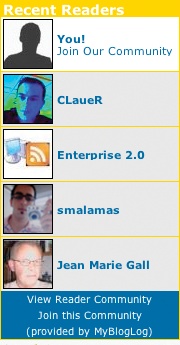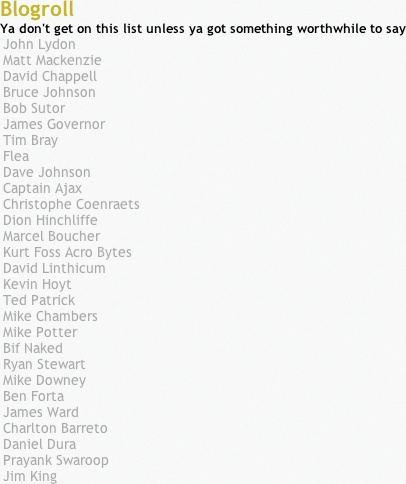The term blog is short for weblog, a personal log (or diary) that is published on the Internet. In many cases, blogs are what personal websites were initially meant to be. Many early website gurus preached the idea that online content should always be fresh and new to keep traffic coming back. That concept holds just as true now as it did then—the content has just shifted form.
Many blogs embrace a variety of the core patterns discussed in Chapter 7, such as:
Participation-Collaboration
Collaborative Tagging
Declarative Living and Tag Gardening
Software as a Service
Asynchronous Particle Update (the pattern behind AJAX)
The Synchronized Web
Structured Information (Microformats)
Static personal websites were, like most websites, intended to be sources of information about specific subjects. The goal of a website was to pass information from its steward to its consumers. Some consumers might visit certain websites (personal or otherwise) only once to retrieve the information they sought; however, certain groups of users might wish to visit again to receive updated information.
In some ways, active blogs are simply personal websites that are regularly updated, though most blog platforms support features that illustrate different patterns of use. Because there are no hard rules for how frequently either a blog or a personal website should be updated, nor is it possible to classify either in a general sense, it is probably not possible to identify clear differences as patterns. However, here are a few key points that differentiate blogs:
Blogs are built from posts—often short posts—which are usually displayed in reverse chronological order (newest first) on an organizing front page. Many blogs also support some kind of archive for older posts.
Personal websites and blogs are both published in HTML. Blog publishing, however, usually uses a slightly different model from traditional HTML website publishing. Most blog platforms don’t require authors to write HTML, letting them simply enter text for the blog in an online form. Blog hosting generally allows users to know less about their infrastructure than classic HTML publishing. Blogs’ ease of use makes them attractive to Internet users who want a web presence but have not yet bothered to learn about HTML, scripts, HTTP, FTP, and other technologies.
Blogs often include some aspects of social networking. Mechanisms such as a blogroll (a list of other blogs to which the blog owner wishes to link from his blog) create mini-communities of like-minded individuals. A blogroll is a great example of the Declarative Living pattern documented in Chapter 7. Comment threads can also help create small communities around websites.
Blogs support mechanisms for publishing information that can be retrieved via multiple patterns (like Search and Retrieve, Push, or Direct Request). Instead of readers having to request the page via HTTP GETs, they can subscribe to feeds (including Atom and RSS) to receive new posts in a different form and on a schedule more convenient to them.
Standard blog software (e.g., Blogger or WordPress) has evolved well beyond simple tools for presenting posts. The software allows readers to add their own content, tag content, create blogrolls, and host discussion forums. Some blog management software lets readers register to receive notifications when there are updates to various sections of a blog. The syndication functionality of RSS (or Atom) has become a core element of many blogs. Many blogs are updated on a daily basis, yet readers might not want to have to reload the blog page over and over until a new post is made (most blog authors do not post exact schedules listing the times their blogs are updated). It is much more efficient if the reader can register interest and then receive a notification whenever new content is published. RSS also describes the content so that readers can decide whether they want to view the actual blog.
Blogs are also moving away from pure text and graphics. All kinds of blog mutations are cropping up, including mobile blogs (known as moblogs), video blogs, and even group blogs.
Developers are adding tools that emphasize patterns of social interactions surrounding blogs. MyBlogLog.com has software that uses an AJAX widget to place the details of readers of a blog on the blog page itself so that you can see who else has been reading a specific blog. Figure 3-18 shows the latest readers of the Technoracle blog at the time of this writing.[39]
Most blog software also offers the ability to socially network with like-minded bloggers by adding them to your blogroll. Having your blog appear on other people’s blogrolls helps to elevate your blog’s status in search engines, as well as in blog directories such as Technorati that track blog popularity. It also makes a statement about your personality and your stance on a variety of subjects. Figure 3-19 shows an example of a blogroll.
A blogroll is a good example of the Declarative Living and Tag Gardening pattern, as the list of fellow bloggers in some ways tags the person who posts it. By making a statement regarding whose blogs they encourage their readers to read, blog owners are declaring something about themselves. Blog readers can learn more about blog writers by looking at who they have on their blogrolls. For example, in Figure 3-19, knowing that John Lydon is in fact Johnny Rotten, the singer for the Sex Pistols, may imply to a reader that the owner of Technoracle has a somewhat disruptive personality and will try to speak the truth, even if it’s unpopular.
Blogs lowered the technical barrier for getting a personal presence on the Internet, making it much easier for many more people to join the conversation. Blogs have also changed the patterns of dissemination of information. Rather than simply reading a news story on a particular topic, interested readers can also find related blogs and find out what the average person thinks about that topic. Blogs represent a new kind of media and offer an alternative source for people who want more than news headlines.
More recently, blogs have evolved beyond their basic form. Blogs have become one of many components in social networking systems like MySpace and Facebook: one component in pages people use to connect with others, not merely to present their own ideas. Going in a different direction, Twitter has stripped blogging down to a 140-character minimalist approach, encouraging people to post tiny bits of information on a regular basis and providing tools for following people’s feeds.


